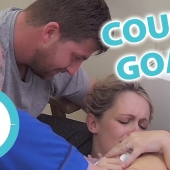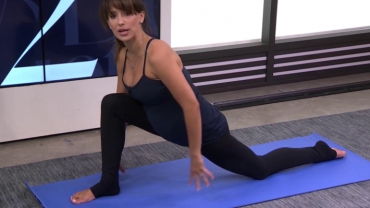Most pregnancies last between 37 and 42 weeks, but it is normal for babies to be born from 3 weeks before to 10 days after a due date.
The first stage of labor often begins with what are called contractions – when the cervix begins to open and thin, and the muscles of the uterus begin to tighten.
During contractions, you may also have an upset stomach, cramps, an aching back, or some pain in your abdomen or thighs. Although this is uncomfortable, it is also very normal.
Labor can last many hours, but your health care team will be with you through each stage of labor, explaining what it happening, and helping to make you as comfortable as possible.
As you learned in chapter two, there are anesthetic and prescription pain relief options that you and your anesthesiologist will discuss. However, as you learned in chapter one, there are other relaxation techniques that you can also practice that don’t involve any medicines.
During labor, it is natural to tense your muscles, increase your rate of breathing – which increases your heart rate – and try to fight whatever pain you are feeling. But in childbirth, it is important to relax your mind and body during labor, which lowers your blood pressure and increases oxygen in your bloodstream, bringing more oxygen to your uterus and baby. Relaxation helps provide comfort.
Some ways to relax may include watching TV, reading a book, listening to music, or talking with family or friends.
In chapter one, you learned about two of the best ways to relax: breathing and guided imagery.
Focusing on your breathing helps lower anxiety. Breathing slowly at first is the best way to relax. You can breathe slowly both during and in between contractions, but keep your breathing even and easy. Soft music may also help you relax.
If you have been practicing the guided imagery techniques you learned about in chapter one, now would be a good time to use these techniques. Allina Health hospitals provide MP3 audio players for guided imagery, or you may bring your own audio player from home. You can also guide yourself to your favorite place simply by closing your eyes and concentrating on the sounds, colors, scents, and textures of the place you are imagining. Again, soft music usually helps. Stay in your favorite place for a few minutes, enjoying peace and comfort.
Moving your body is also a very good way to ease discomfort during labor. Lying in the same position for too long can be painful, and it can slow labor. Change positions often. If your health care team says it is okay, take a walk in the hallway, having a family member or friend help you, if necessary.
If you have been practicing the different body-positioning techniques mentioned in chapter one, have a partner or family member help you with these exercises. Anything you can do to move your body will be helpful during labor.
Something cold can also dull pain, and heat can help you relax. For cold therapy, try applying an ice pack to an area that is causing you discomfort. For warmth, a heat pack, or a warmed blanket can be helpful. Wrap cold and hot items in a towel to protect your skin.
Asking a partner, family member, or friend to give you a foot, hand, or shoulder massage can help relieve emotional tension, anxiety, and pain during labor. Even a light touch – like the stroking of your hair or your forehead – can be very soothing.
As contractions get stronger, you may feel some pain in your lower back. The heel of a hand or even a tennis ball in this area can be comforting.
As you learned in chapter one, breathing the essential oils in aromatherapy can also help reduce anxiety, ease your pain, and help you feel better during labor.
Ask your health care team if it is okay to bathe. The feeling of warm water from a bath or shower may help you relax during labor. It is important to keep the water temperature around body temperature – 98 to 100 degrees Fahrenheit. – to prevent fever in you and the baby.
Remember to give yourself positive and encouraging messages, which are called labor affirmations. Say them out loud or to yourself, but say things that are important to you, such as ‘My body knows what to do’, or ‘I am doing fine, and my baby is doing fine.’ Whatever positive things you wish to say will be very helpful in relieving anxiety as you get ready to give birth.
Labor can be a challenging experience, but you have learned many ways to help you relax and ease any discomfort. If at all possible, try to sleep between contractions. This will help conserve your energy for the second stage of labor, when your baby is born.
Always remember, giving birth is a natural experience, and your body is strong enough to handle it. Your health care team will be with you every step of the way to help you cope with any discomfort as you give birth to your baby.
- 3018 views













